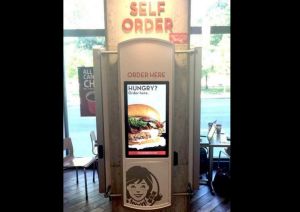On February 27, 2017, Tyler Durden writes on Zerohedge:
In yet another awkwardly rational response to government intervention in deciding what’s “fair”, the blowback from minimum wage demanding fast food workers has struck again. Wendy’s plans to install self-ordering kiosks in 1,000 of its stores – 16% of its locations nationwide.
“Last year was tough — 5 percent wage inflation,” said Bob Wright, Wendy’s chief operating officer, during his presentation to investors and analysts last week. He added that the company expects wages to rise 4 percent in 2017. “But the real question is what are we doing about it?”
Wright noted that over the past two years, Wendy’s has figured out how to eliminate 31 hours of labor per week from its restaurants and is now working to use technology, such as kiosks, to increase efficiency.
Wendy’s chief information officer, David Trimm, said the kiosks are intended to appeal to younger customers and reduce labor costs. Kiosks also allow customers of the fast food giant to circumvent long lines during peak dining hours while increasing kitchen production.
As Dispatch.com reports, the Dublin-based burger giant started offering kiosks last year, and demand for the technology has been high from both customers and franchise owners.
“There is a huge amount of pull from (franchisees) in order to get them,” David Trimm, Wendy’s chief information officer, said last week during the company’s investors’ day.
“With the demand we are seeing … we can absolutely see our way to having 1,000 or more restaurants live with kiosks by the end of the year.”
A typical store would get three kiosks for about $15,000. Trimm estimated the payback on those machines would be less than two years, thanks to labor savings and increased sales. Customers still could order at the counter.
Kiosks are where the industry is headed, but Wendy’s is ahead of the curve, said Darren Tristano, vice president with Technomic, a food-service research and consulting firm.
“They are looking to improve their automation and their labor costs, and this is a good way to do it,” he said.
Who could have seen that coming? As we noted previously, minimum wage laws – while advertised under the banner of social justice – do not live up to the claims made by those who tout them. They do not lift low wage earners to a so-called “social minimum”. Indeed, minimum wage laws — imposed at the levels employed in Europe — push a considerable number of people into unemployment. And, unless those newly unemployed qualify for government assistance (read: welfare), they will sink below, or further below, the social minimum.
As Nobelist Milton Friedman correctly quipped, “A minimum wage law is, in reality, a law that makes it illegal for an employer to hire a person with limited skills.”
Despite the piling up mountain of evidence on the harmful “unintended consequences” of artificially high minimum wages, we suspect we already know how this story ends. After all, it’s much easier to win elections by promising people more stuff rather than less. And, as an added bonus, when it all goes horribly wrong it’s very easy to lame the blame at the feet of the wealthy 1%’ers who are behind all the layoffs. Checkmate.
This is yet another recent article that looks at a future where there will be hordes of citizens of zero economic value as tectonic shifts in the technologies of production destroy jobs and devalue the worth of labor. That is, unless the system can be reformed to empower EVERY citizen to acquire OWNERSHIP in the wealth-creating, income-producing capital assets resulting from technological invention and innovation.
Using common sense, if raising the minimum wage will not kill jobs then why not raise the minimum wage to $25.00 or $50.00 or $100.00 per hour? Of course there are consequences that either are reflected in job elimination or increased prices. Virtually never are the OWNERS of corporations willing reduce profits. If wage levels were not a factor there would be no reason for ANY company to exit production in the United States and move production to foreign lands with significantly less labor costs. Also, there is the impact on pricing levels, as any increases in the cost of production or service always results in pricing increases.
If this were not the case, then no companies would be compelled to seek other more cost-efficient means of production or to move production to foreign countries whose workers are paid far less than Americans. Increasingly, companies are seeking more efficient and less long term costs that non-human technology can deliver to reduce their operating costs, provide higher build quality, automate service, and maximize profits for their OWNERS. As is virtually always the case, the OWNERS of companies do not want to reduce profits.
What the proponents of raising the minimum wage fundamentally are addressing is that low-paid American workers need to earn more income.
Rather than focus on Job Creation, Job Retraining, and a redistributed Minimum Guaranteed Income that holds back technological invention and innovation, our economic policies should focus on wealth-creating, income-producing capital Ownership Creation.
Given that there is no question that robotic technology will continue to expand the productivity and in large measure destroy jobs and devalue the value of human labor, the question that SHOULD be urgently addressed is WHO SHOULD OWN THE FUTURE TECHNOLOGY ECONOMY? Will ownership continue to concentrate among the 1 percent wealthy ownership class who now OWNS America, or will we reform the system to provide equal opportunity for EVERY child, woman, and man to acquire personal OWNERSHIP in FUTURE non-human capital assets paid for with the FUTURE earnings of the investments in our technological future?


